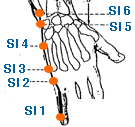SI 1 SI1 Lesser Marsh Shao Ze 少澤 small intestine 1 Small Intestine 1 si1
Back to meridian
SI 1 SI1
SI 1 SI1
SI 1 Lesser Marsh - Shao Ze - 少澤

Location
.1 cun posterior to the corner of the nail on the ulnar side of the little finger.
Actions
- Breast disorders of any etiology, insufficient lactation, mastitis, breast abscess, cysts.
- Jing Well Point, clear heat from the opposite end of the channel, for eye redness, earache, tinnitus, sore throat, stiff tongue.
- Headache, dizziness, loss of consciousness.
- Local point for problems of the little finger and the course of the channel - pain and/or weakness of the arm and/or shoulder.
Back to meridian
